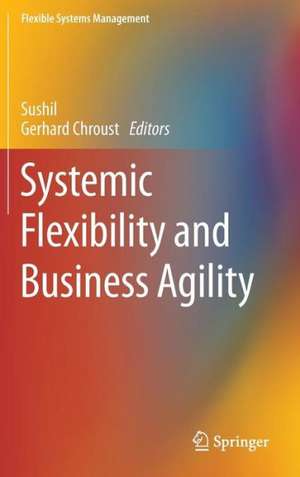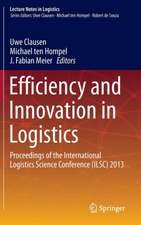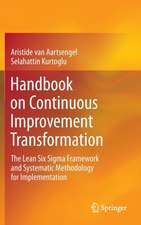Systemic Flexibility and Business Agility: Flexible Systems Management
Editat de Sushil, Gerhard Chrousten Limba Engleză Hardback – 5 ian 2015
Flexibility and agility in business are emerging as key dimensions of business excellence that encompass the requirements of both choice and speed. The two concepts, flexibility and agility, have been used in multiple ways and often interchangeably, both in literature and in practice. The growing need for flexibility/agility in business can be seen from reactive as well as proactive perspectives. A business enterprise is expected to possess reactive flexibility/ agility (as adaptability and responsiveness) in order to cope with the changing and uncertain business environment. It may also endeavor to intentionally generate flexibility/agility as a strategic change in a variety of ways, such as leadership change, reengineering, innovation in products and processes, use of information and communication technology, and learning orientation.
| Toate formatele și edițiile | Preț | Express |
|---|---|---|
| Paperback (1) | 647.27 lei 6-8 săpt. | |
| Springer India – 14 oct 2016 | 647.27 lei 6-8 săpt. | |
| Hardback (1) | 653.65 lei 6-8 săpt. | |
| Springer India – 5 ian 2015 | 653.65 lei 6-8 săpt. |
Din seria Flexible Systems Management
- 18%
 Preț: 954.62 lei
Preț: 954.62 lei - 17%
 Preț: 460.35 lei
Preț: 460.35 lei - 18%
 Preț: 954.93 lei
Preț: 954.93 lei - 18%
 Preț: 953.35 lei
Preț: 953.35 lei - 15%
 Preț: 649.06 lei
Preț: 649.06 lei - 18%
 Preț: 1005.74 lei
Preț: 1005.74 lei - 15%
 Preț: 646.30 lei
Preț: 646.30 lei - 15%
 Preț: 643.84 lei
Preț: 643.84 lei - 18%
 Preț: 950.33 lei
Preț: 950.33 lei - 24%
 Preț: 802.76 lei
Preț: 802.76 lei - 18%
 Preț: 793.14 lei
Preț: 793.14 lei - 15%
 Preț: 584.58 lei
Preț: 584.58 lei - 15%
 Preț: 644.18 lei
Preț: 644.18 lei - 18%
 Preț: 1003.24 lei
Preț: 1003.24 lei - 18%
 Preț: 1008.12 lei
Preț: 1008.12 lei
Preț: 653.65 lei
Preț vechi: 769.00 lei
-15% Nou
Puncte Express: 980
Preț estimativ în valută:
125.09€ • 135.83$ • 105.08£
125.09€ • 135.83$ • 105.08£
Carte tipărită la comandă
Livrare economică 22 aprilie-06 mai
Preluare comenzi: 021 569.72.76
Specificații
ISBN-13: 9788132221500
ISBN-10: 8132221508
Pagini: 400
Ilustrații: XVII, 416 p. 78 illus., 57 illus. in color.
Dimensiuni: 155 x 235 x 30 mm
Greutate: 0.79 kg
Ediția:2015
Editura: Springer India
Colecția Springer
Seria Flexible Systems Management
Locul publicării:New Delhi, India
ISBN-10: 8132221508
Pagini: 400
Ilustrații: XVII, 416 p. 78 illus., 57 illus. in color.
Dimensiuni: 155 x 235 x 30 mm
Greutate: 0.79 kg
Ediția:2015
Editura: Springer India
Colecția Springer
Seria Flexible Systems Management
Locul publicării:New Delhi, India
Public țintă
ResearchCuprins
Part I: Systemic and Strategic Flexibility.- Chapter 1. Diverse Shades of Flexibility and Agility in Business.- Chapter 2. New Research Perspectives on Managing Diversity in International ICT Project Teams.- Chapter 3. Elements of Flowing Stream Strategy Crystal for Telecom Service Providers.- Chapter 4. Interaction of Continuity and Change Forces and E-government Performance.- Chapter 5. Development of Flexible Strategy Game-card: A Case Study.- Chapter 6. Flexible Strategy Game Card: Framework for Effective Strategy Execution.- Part II: Information and Business Agility.- Chapter 7. Strategic Flexibility in Exploiting Economies of Scope on 70-30 Principle – A Case Study of Japanese Electronics Industry.- Chapter 8. Developing Personal Flexibility as a Key to Agile Management Practice.- Chapter 9. Flexibility in e-learning through Knowledge Management Practices: A Case Study.- Chapter 10. Flexibility of Processes and e-Governance Performance.- Chapter 11. Workflow Automation Process for a Reinsurance Company using BPM Tool: A Stakeholder Engagement Perspective.- Chapter 12. Localization, Cultural Preferences and Global Commerce - Software Like a Cooperative Partner.- Part III: Flexibility, Innovation and Business Excellence.- Chapter 13. Critical Processes for Organization Vitality: A Conceptual Study.- Chapter 14. How Flexible is the Strategic Innovative Performance Target Design without Sacrificing Lead Time?.- Chapter 15. Time Bound Formalization and its Role in Building Team Flexibility in Product Development Organizations.- Chapter 16. Next Generation Business Excellence Model: Integrating Flexibility Dimension.- Chapter 17. Flexibility as a Strategy for Reducing Cost of Renovation in Building Construction Projects.- Chapter 18. Establishing Visibility across Value Chain of a Beverage Giant by Implementing Flexible Systems.- Part IV: Flexibility in Value and Supply Chains.- Chapter 19. Structural Flexibility in Supply Chains:TISM and FISMApproach.- Chapter 20. A Model for Enablers of Supply Chain Flexibility.- Chapter 21. Decision Modeling Approach for Eco-Driven Flexible Green Supply Chain.- Part V: Financial Flexibility and Mergers & Acquisitions.- Chapter 22. Innovative Mode of Financing and Abnormal Returns to Shareholders of Indian Acquiring Firms.- Chapter 23. Multiple Perspectives of Mergers and Acquisitions Performance.- Chapter 24. A System Dynamics Model of Post Merger Integration.
Notă biografică
Professor Sushil is Abdulaziz Alsagar Chair Professor (Professor of Strategic, Flexible Systems and Technology Management), and Chair, Strategic Management Group at the Department of Management Studies, Indian Institute of Technology Delhi, India. He has served as Visiting Professor and delivered seminars in many leading universities; some representative ones are University of Minnesota, Minneapolis, MN, Stevens Institute of Technology, NJ, University of Lethbridge, Alberta, Université Paris 1 Panthéon-Sorbonne, Paris, among others. He is an active researcher and supervised more than 50 doctoral dissertations. He is having eighteen books to his credit in the areas of Flexibility, Strategy, Systems Thinking, and Technology Management. He has over 250 papers in various refereed journals and conferences. He has pioneered the area of ‘Flexible Systems Management’ and made original contributions to the field of knowledge in the form of interpretive approaches in management. He is the Founder Editor-in-chief of Global Journal of Flexible Systems Management and serving on the Editorial Boards of leading international journals. He is the Founder President of the professional body, ‘Global Institute of Flexible Systems Management’. Currently he is serving as Independent Director on the Boards of RINL, HSCC, and River Engineering.
Gerhard Chroust is Professor Emeritus for Systems Engineering and Automation, Institute of System Sciences, Johannes Kepler University of Linz, Austria. From 1992 until 2007 he was Professor for 'Systems Engineering and Automation' at the Kepler University of Linz and Department Head of the Department (in 2004 transferred into an Institute) of Systems Engineering and Automation from 1992 until 2007. He is the Editor-in-Chief of the IFSR Newsletter, Chairperson of the Editorial Board of the Book Series of the Austrian Computer Society (OCG), and Editorial Board Member of several journals. He has written,co-authored and edited a dozen books and over 400 articles, papers and other publications. His research interests are in the fields of Software Engineering (Representation and Enactment of Software Process Models, Quality and Improvement of Development Processes), Systems Science and Systemic Aspects of Engineering, Emergence, History of Computers and Information Technology, and Human Aspects of Software Development.
Gerhard Chroust is Professor Emeritus for Systems Engineering and Automation, Institute of System Sciences, Johannes Kepler University of Linz, Austria. From 1992 until 2007 he was Professor for 'Systems Engineering and Automation' at the Kepler University of Linz and Department Head of the Department (in 2004 transferred into an Institute) of Systems Engineering and Automation from 1992 until 2007. He is the Editor-in-Chief of the IFSR Newsletter, Chairperson of the Editorial Board of the Book Series of the Austrian Computer Society (OCG), and Editorial Board Member of several journals. He has written,co-authored and edited a dozen books and over 400 articles, papers and other publications. His research interests are in the fields of Software Engineering (Representation and Enactment of Software Process Models, Quality and Improvement of Development Processes), Systems Science and Systemic Aspects of Engineering, Emergence, History of Computers and Information Technology, and Human Aspects of Software Development.
Textul de pe ultima copertă
This book provides a conceptual framework for systemic flexibility and business agility, drawing on a basis of research/case applications in various types of flexibility and agility in business. The selected papers address a variety of issues concerning the theme of systemic flexibility and business agility and are organized into following five parts: (i) Systemic and Strategic Flexibility; (ii) Information and Business Agility; (iii) Flexibility, Innovation and Business Excellence; (iv) Flexibility in Value and Supply Chains; and(v) Financial Flexibility and Mergers & Acquisitions.
Flexibility and agility in business are emerging as key dimensions of business excellence that encompass the requirements of both choice and speed. The two concepts, flexibility and agility, have been used in multiple ways and often interchangeably, both in literature and in practice. The growing need for flexibility/agility in business can be seen from reactive as well as proactive perspectives. A business enterprise is expected to possess reactive flexibility/ agility (as adaptability and responsiveness) in order to cope with the changing and uncertain business environment. It may also endeavor to intentionally generate flexibility/agility as a strategic change in a variety of ways, such as leadership change, reengineering, innovation in products and processes, use of information and communication technology, and learning orientation.
Flexibility and agility in business are emerging as key dimensions of business excellence that encompass the requirements of both choice and speed. The two concepts, flexibility and agility, have been used in multiple ways and often interchangeably, both in literature and in practice. The growing need for flexibility/agility in business can be seen from reactive as well as proactive perspectives. A business enterprise is expected to possess reactive flexibility/ agility (as adaptability and responsiveness) in order to cope with the changing and uncertain business environment. It may also endeavor to intentionally generate flexibility/agility as a strategic change in a variety of ways, such as leadership change, reengineering, innovation in products and processes, use of information and communication technology, and learning orientation.
Caracteristici
Presents a conceptual framework of the key dimensions of business excellence: Flexibility and Agility Collates high quality researches/case applications supported by many illustrations and tabular compilation Brings multiple facets of flexibility and agility in organizations in a single volume Includes supplementary material: sn.pub/extras











